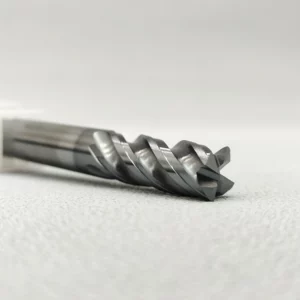1. Durabilité et résistance à la chaleur :
One of the primary concerns when cutting stainless steel is the high heat generated during the machining process. Therefore, the best end mills for stainless steel cutting are those made from high-quality materials that offer exceptional durability and heat resistance. Tungsten carbide, for instance, is an ideal choice as it possesses excellent hardness and can withstand the extreme temperatures generated during the cutting operation.
2. Cutting Edge Geometry:
The next important aspect to consider is the cutting-edge geometry of the end mill. For stainless steel cutting, end mills with a high helix angle and sharp cutting edges perform exceptionally well. The high helix angle allows for efficient chip evacuation, preventing chip buildup and reducing the chances of tool wear and breakage. Sharp cutting edges ensure clean and precise cuts without causing workpiece deformation.
3. Coating and Lubrication:
Coatings play a pivotal role in improving the lifespan and performance of end mills for stainless steel cutting. The most common coating used is titanium nitride (TiN), which enhances the hardness of the tool and provides excellent resistance to wear and abrasion. Additionally, lubrication is essential to minimize friction and heat generation. Applying a suitable lubricant or coolant during the machining process can significantly enhance overall performance and prevent premature tool failure.
4. Applications and Benefits:
End mills for stainless steel cutting find widespread use in various industries, including aerospace, automotive, and medical. Their applications range from machining stainless steel components for surgical instruments to manufacturing precision parts for aircraft engines. By employing the best end mills for stainless steel cutting, customers can experience several key benefits, including:
– Enhanced productivity: The precise cutting capabilities of these end mills minimize the need for secondary operations, resulting in reduced machining time and increased productivity.
– Superior surface finish: The high rigidity and sharpness of the cutting edges promote clean and burr-free cuts, ensuring a smooth and refined surface finish on the stainless steel workpiece.
– Extended tool life: With their exceptional durability and heat resistance, these end mills can withstand the demands of prolonged cutting, reducing tool replacement frequency and increasing cost-effectiveness.
– Versatility: The best end mills for stainless steel cutting exhibit versatility, enabling users to handle a wide range of stainless steel alloys and varying machining requirements.
– Consistency and precision: By utilizing end mills designed specifically for stainless steel cutting, customers can achieve consistent and precise cuts with tight tolerances, ensuring the desired levels of accuracy and repeatability in their manufacturing processes.
Selecting the right end mills for stainless steel cutting is paramount for achieving superior results in terms of precision, productivity, and cost-effectiveness. By considering factors like durability, cutting-edge geometry, coatings, and lubrication, customers can make an informed choice that aligns with their specific application requirements.
